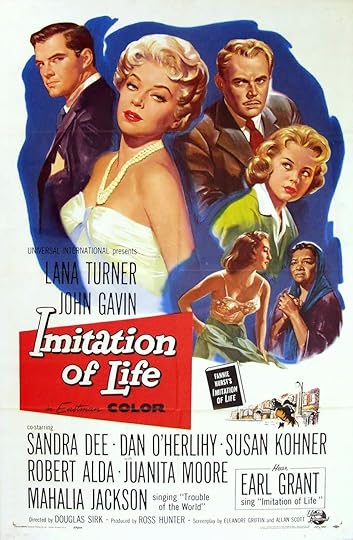99 Years a Maid: Remembering Juanita Moore and Imitation of Life

It’s Black History Month, and 12 Years A Slave is gaining momentum in this year’s Oscar derby. Which makes this a great time to salute Juanita Moore, a 1960 Oscar nominee who died in January at age 99. Moore nabbed a Best Supporting Actress nomination for the Douglas Sirk version of Imitation of Life, playing a housekeeper who is cruelly rejected by her light-skinned daughter. After her Oscar glory (she was beaten out by Shelley Winters in The Diary of Anne Frank), Moore hoped to have her pick of challenging roles. But since black actresses usually played domestics, her career essentially stalled, though she was still performing on TV as late as 2001.
Imitation of Life, based on a tear-jerking 1933 novel by Fannie Hurst, has been filmed by Hollywood twice. The 1934 production, starring Claudette Colbert and Louise Beavers, fascinates me most. It’s the tale of two widows and their daughters. Colbert, needing help in making ends meet, joins forces with her housekeeper (Beavers) to open a pancake restaurant. Soon their packaged pancake mix becomes wildly popular, with Beavers functioning as an Aunt Jemima-like corporate symbol and earning a share of the profits. This progressive story of two women (one black, one white) successfully doing business together contrasts with more personal complications. While Colbert and her offspring melodramatically fall for the same man, Beavers grapples with the fact that her own daughter wants nothing to do with the black world, and is determined to pass for white. This daughter, Peola, is played by Fredi Washington, an African-American with fair skin and light eyes, whose unlikely looks and determination to stay true to her heritage cut her off from future opportunities in Hollywood, with studio bosses insisting she was not dark enough to be cast in “Negro” roles. (Washington later became an early civil rights activist and co-founder of the Negro Actors Guild of America.)
The 1934 Imitation of Life struggled to pass muster with the Hays Office, which opposed anything in Hollywood films that might smack of miscegenation. Though clearly the character of Peola has significant white as well as black ancestry, the issue is never addressed. And the big scene in which Peola ventures into the white world is all about being a cashier in a restaurant: there’s no sexual undercurrent, no confrontation with a white suitor newly aware of her past.
The 1959 film starring Lana Turner and Juanita Moore changes a lot. Now the leading white character is a glamorous actress, and Moore plays her maid and confidante. Adorable Sandra Dee is Turner’s daughter, while John Gavin is cast as the photographer for whom they vie. Once again, the black daughter (renamed Sarah Jane) rejects the facts of her birth in order to pass as white, appalling Moore, who intones, “It’s a sin to be ashamed of what you are. . . . The Lord must have had his reasons for making some of us white and some of us black.” But the old taboo that barred scenes between a black woman and a white man is gone now, leading to the dramatically charged moment when Sarah Jane is beaten by her white boyfriend and left bleeding in the gutter. In any case, the taboo might not have mattered, because Sarah Jane is played by Susan Kohner, dark-eyed daughter of a Mexican mother (Lupita Tovar) and an Eastern European Jewish father (Hollywood superagent Paul Kohner). Susan Kohner is hardly African-American, but she, like Moore, was Oscar-nominated for her powerhouse performance.
Happily for Lupita Nyong’o, today’s Hollywood can appreciate a black actress playing a black role.

Published on February 21, 2014 10:46
No comments have been added yet.
Beverly in Movieland
I write twice weekly, covering topics relating to movies, moviemaking, and growing up Hollywood-adjacent. I believe that movies can change lives, and I'm always happy to hear from readers who'd like t
I write twice weekly, covering topics relating to movies, moviemaking, and growing up Hollywood-adjacent. I believe that movies can change lives, and I'm always happy to hear from readers who'd like to discuss that point.
...more
- Beverly Gray's profile
- 10 followers



